What Is Direct-to-Consumer Marketing?
Direct-to-consumer marketing is when your business sells products or services directly to end-customers. In other words, you don’t use an intermediary, such as a traditional retailer to sell your products.
For example, let’s say you make meal kits. You could sell your product through one or more supermarkets. But in a D2C model, you would sell it directly to customers via your website.
Supermarkets get a ton of footfall. Simply having your meal kits on their shelves means people will see your brand and might decide to try it.
But if you aren’t in the supermarket, you have to ensure they see your product through other means.
That’s where D2C marketing comes in. It ensures customers become aware of your product and choose to buy it using channels like:
- Advertising
- Sponsorship
- Online videos
- Reviews
- Getting featured in food magazines or on food websites
- Social media
The D2C business model suits some businesses better than others. Let’s take a look at the pros and cons.
Pros
✔️ More control: You get complete control over how your brand is presented and marketed to customers.
✔️ Better profits: Intermediaries always take a proportion of your revenue. By selling directly, you get to keep a larger share of your revenue.
✔️ Build relationships: Because you interact directly with customers, you get to build a personal connection with them. This enables you to build customer loyalty by ensuring they feel valued.
✔️ More agile: Selling through an intermediary comes with many logistical issues. For example, the supermarket might demand a bulk order of your meal kits, only for them to not sell. D2C gives you more flexibility to react to demand and make changes to your business.
✔️ Better insights: Selling directly to your consumers lets you gather information about their behavior, preferences, and purchasing patterns. By analyzing this customer data, you can make strategic decisions that better meet your customers’ needs.
Cons
❌ Greater responsibility: As well as manufacturing your product, you’ll also be 100% responsible for its sales and marketing.
❌ Increased logistics: You’ll need to handle the delivery and returns of your products. This involves coordinating with carriers, tracking shipments, and resolving any issues related to delivery delays or lost packages.
❌ Higher risk: You have to deal with any operational issues that arise. For example, suppose there are severe weather conditions and you cannot deliver your products. In that case, you are responsible for letting customers know, ensuring they are still happy and avoiding a delivery backlog. In a traditional model, the intermediary would deal with these issues.
❌ It can take time to build momentum: Attracting customers can take time without a well-known brand behind you. ❌ Intermediaries are set up to sell: When someone visits an intermediary, they usually plan on making a purchase. This puts them in a buying mood and makes them more likely to purchase additional products. D2C businesses often miss out on this buying environment.
6 D2C Marketing Techniques to Capitalize on Demand
Today, nearly two-thirds of Americans buy directly from brands. Here are six digital marketing strategies that can help ensure your business gets its share of this demand.
1.Organic search marketing (SEO)
This involves creating content that ranks high on Google for common user queries related to your products.
For example, if you create meal kits, you could target search terms like:
- Best vegan meal kits
- How to save time cooking
- Healthy eating tips
You then create content around the subject that also happens to introduce your product.
Why organic search marketing is good for D2C marketing
Search marketing offers several benefits to D2C subscription businesses:
✔️ Increase traffic to your website: Once on your page, users may decide to visit other parts of your website.
✔️ Relevance: Because people have typed a search term related to your product or service, the chances are they will be interested in it.
✔️ Brand awareness: Your brand will be introduced to new customers who discover your content in search results.
✔️ Increased brand value: Good quality, valuable content will display your industry expertise and experience, which will increase your brand value.
✔️ Measurable: You can track consumer behavior metrics, such as how many people land on individual blog posts, how long they read them for, and how many click on CTAs. This allows you to optimize your search marketing campaigns
✔️ Boost sales: A good blog article always includes a link to where customers can buy your product or service.
Search engine optimization
On average, the top three Google results for any search query get just over two-thirds of all traffic. Results on page two get virtually none. In other words, if your content doesn’t rank high, no one will see it.
So how can you make sure it’s seen? The answer is search engine optimization (SEO). This is a series of techniques that ensure search engines understand your content and rank it higher.
Typical SEO techniques include:
- Add keywords: Keywords are the search terms that people type into search engines. Content that includes the search term in the headings, image descriptions and body text is more likely to rank higher in results. Tools like Surfer SEO can recommend which keywords to include in your content.
- Get backlinks: If many other websites publish links to yours, then it signals to search engines that people online like your content. They will be more likely to rank it higher.
- Improve page speed: Google prioritizes sites that offer a good user experience and part of this is how fast your website loads. You can test this by visiting Google PageSpeed Insights.
- Mobile-friendly: Another user experience factor is whether your website is optimized for different screen sizes. Most website builders or hosting packages do this as standard today.
- Keep your site updated: Regularly post new content and overhaul existing blogs. This shows Google that your site provides up-to-date information.
2.Influencer marketing
Influencers are the personalities that are well-known throughout your niche. They usually have one or more of the following:
- A podcast
- A blog
- A YouTube channel
- A strong social media presence
Influencer marketing involves building relationships with these personalities. The idea is that you get your D2C subscription box in front of them and if they like it, they will mention it on one or more of their channels.
Why influencer marketing is good for D2C marketing
✔️ Trust: Influencers have loyal fanbases who trust their opinions.
✔️ Exposure to new audiences: Influencers put you in front of potential customers who align with your brand’s values.
✔️ SEO benefits: Influencer marketing can help you build links, which helps your content rank higher in search results.
Here are some ways you can get your products mentioned by influencers:
- Send a gift: Send the influencer your subscription box and ask them what they think. Don’t ask them to mention it; let it happen naturally.
- Collaborate: You could contact the influencer and suggest that they feature your product. In exchange, you help them promote the video.
- Affiliate marketing: This is when you offer content creators the opportunity to earn a commission when viewers click a link to your website from their channel and make a purchase.
- Sponsorship: You could go one step further and pay the influencer to feature your products. Most followers trust influencers to only feature products they like, even if they state that it is sponsored.
Here’s a good example, where fragrance subscription service Scentbird got one of its products featured by TikTok influencer fancylikegracie.

To learn more, check out our article on how to use influencer marketing to promote your subscription box.
3. PR
This is the classic practice of getting your D2C products mentioned in the news.
Getting mentioned in the press works because media organizations have massive brand recognition, large readerships and are trusted by their readers.
There are a few ways you can earn press mentions:
✔️ Get quoted by journalists on a relevant story: For example, if you run a pet food subscription box and a journalist is writing an article about cat nutrition, they might ask you for an expert opinion.
✔️ Do something that generates headlines: For example, the owners of this subscription dog food business made headlines by claiming that they taste-test the food themselves.

✔️ Publish research: Journalists love stats and facts. If you carry out research and publish the findings, then there’s a good chance the industry press will cover them.
✔️ Host events: People are always looking for something interesting to do, so if you can host a fun or interesting event in your area, the press might tell their readers about it.
4. Social media marketing
Social media is a great way to engage with new potential customers and build a following online. It’s great for D2C marketing because it:
✔️ Is free
✔️ Allows you to build direct relationships with potential customers
✔️ Is flexible—you can use it in a variety of different marketing campaigns from brand building to boosting sales.
Here are some ways to market your D2C brand on social media:
💡 Engage in online conversations: One of the best ways to build followers on social media is to simply be active—join groups, answer people’s questions and contribute to conversations.
For example, the nutrition brand Huel often engages in relevant online conversations, responding to customer feedback, addressing concerns, and sharing user-generated content.
In the example below, one of Huel’s many online followers has tagged the brand in answer to someone’s question.
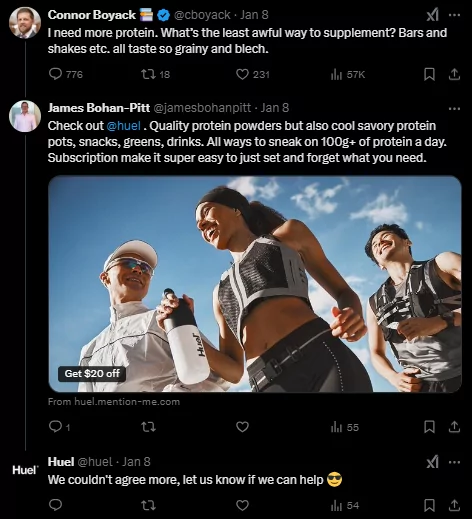
💡 Share content: If you’ve created great content for your website, then sharing it on social media ensures it gets an audience.
In the example below, the online D2C brand Bespoke Post has shared five positive resolutions its followers can make in the New Year.
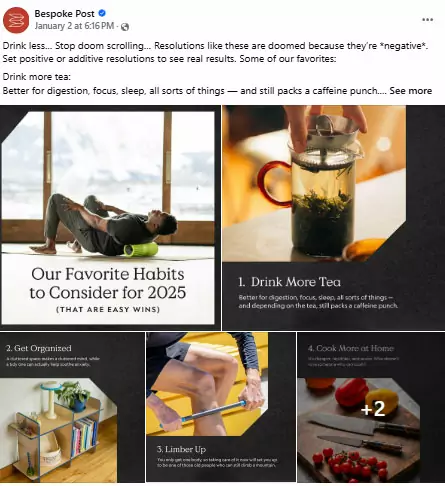
💡 Tell followers what you are doing: Your everyday work might seem unremarkable, but it could interest your followers. It also allows you to show off the passion and expertise that goes into your products.
Post updates and share images of you:
- Visiting suppliers
- Attending events
- Meeting customers
- Creating your products
In the example below, the flower subscription service, Freddies’ Flowers has posted about a visit to one of its suppliers.
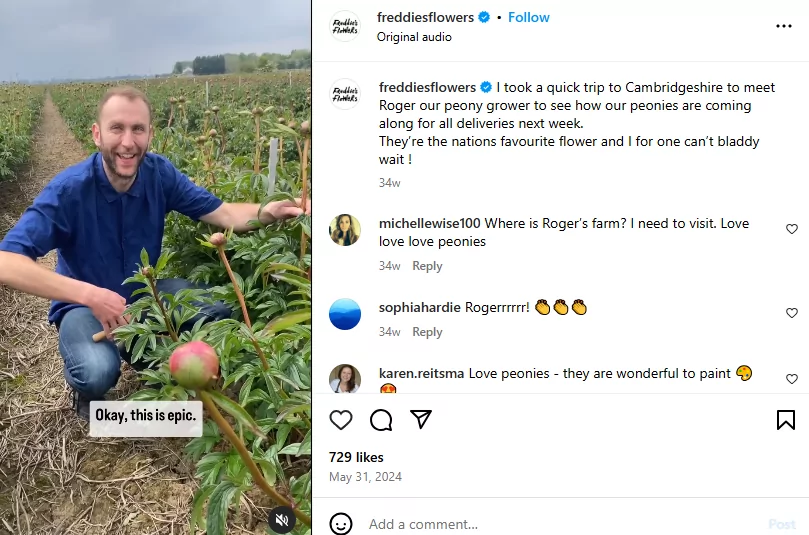
5.Email marketing
Email marketing is still surprisingly effective, with an ROI of $36 for every $1 invested.
It’s a middle or bottom-of-the-funnel technique—in other words, people are already aware of your brand and choose to engage with it further.
This means your email marketing campaigns need to:
- Offer subscribers value so the relationship continues to develop and improve.
- Convert some readers by encouraging them to buy your products.
One of the best ways to do this is by providing a newsletter or something similar. This could include news and tips that your audience might be interested in and an offer to encourage them to buy.
Shaving D2C brand Dollar Shave Club’s emails typically include:
- Product updates: Information about new products or improvements to existing ones.
- Grooming tips: Advice and articles related to men’s grooming and personal care.
- Promotions: Exclusive offers or discounts for subscribers.
- Engaging content: Humorous and relatable content that aligns with the brand’s voice.

To learn more, check out our guide to subscription box email marketing.
6. Pay-per-click advertising
Pay-per-click (PPC) advertising is a form of online advertising where you only pay when someone clicks on your ad.
PPC is common on search engines and social media platforms. For example, the sponsored results at the top of Google are PPC ads.
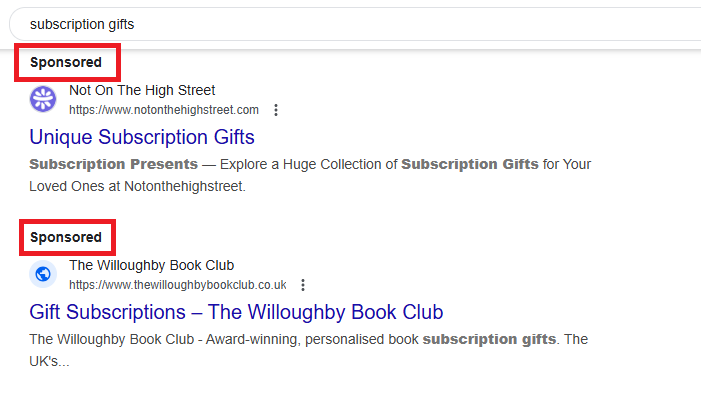
PPC ads work well for D2C marketing because they enable you to target:
- Your ideal customers: Most PPC platforms include segmentation tools so you can choose to show your ads only to people who match your ideal customer profile. This makes PPC ads more efficient because you’re only paying for customers most likely to buy your products.
- Keywords: Keywords are the terms people type when searching for information. You can show PPC ads to people who type specific keywords. This is useful because the keyword they type gives you an insight into how likely they are to buy and what they are interested in. For example, if someone types “buy cheap jewelry”, you know that the person is ready to buy jewelry but doesn’t want to spend a lot.
How you launch a PPC ad campaign varies between platforms. However, these are the main steps you’ll often need to take:
Create a landing page: When someone clicks your PPC ad, they will get taken to a page on your website. This is your landing page and a good one should:
- Allow the customer to quickly and easily make a purchase, for example, by providing clear calls-to-action.
- Reassure the customer that buying your product or service will help them – for example, by including positive customer reviews.
- Answer any questions that they might have.
Choose keywords: Most PPC platforms require you to bid on keywords. The more you bid, the more likely your ad will be shown when someone types that keyword. Some keywords are more likely to result in a sale than others and are often more competitive.
Aim to find keywords that are:
✔️ Relevant to your product.
✔️ Show strong purchase intent
✔️ Are not too competitive
✔️ You don’t have to bid too much for
Choose negative keywords: You don’t want to waste money attracting searches that don’t result in more sales. Negative keywords allow you to choose specific keywords you want to avoid being shown for.
Create ad content: Now it’s time to create the copy and imagery for the ad itself. Ensure whatever you produce is engaging, relevant and high-quality.
Launch: Once you’ve launched your campaign, make sure to monitor your campaign’s metrics, including:
- Click-through-rate: How many people are clicking on your ad.
- Conversion rate: How many people who click your ad make a purchase.
If you’re selling a subscription box directly to consumers, then your website is your most important marketing channel. All other digital channels point to it and it’s where customers spend money with you.
However, managing subscriptions often takes additional functionality that most ecommerce platforms don’t offer as standard.
For example, Shopify requires you to use third-party plugins to enable subscriptions. However, these are often inflexible and don’t enable you to offer a range of options to customers.
Subbly is an all-in-one ecommerce platform dedicated to subscription-first businesses.
It enables you to build incredible websites that perfectly meet your customer’s needs.
Want to understand what is possible? Then check out this website we created for an imaginary D2C protein subscription brand.
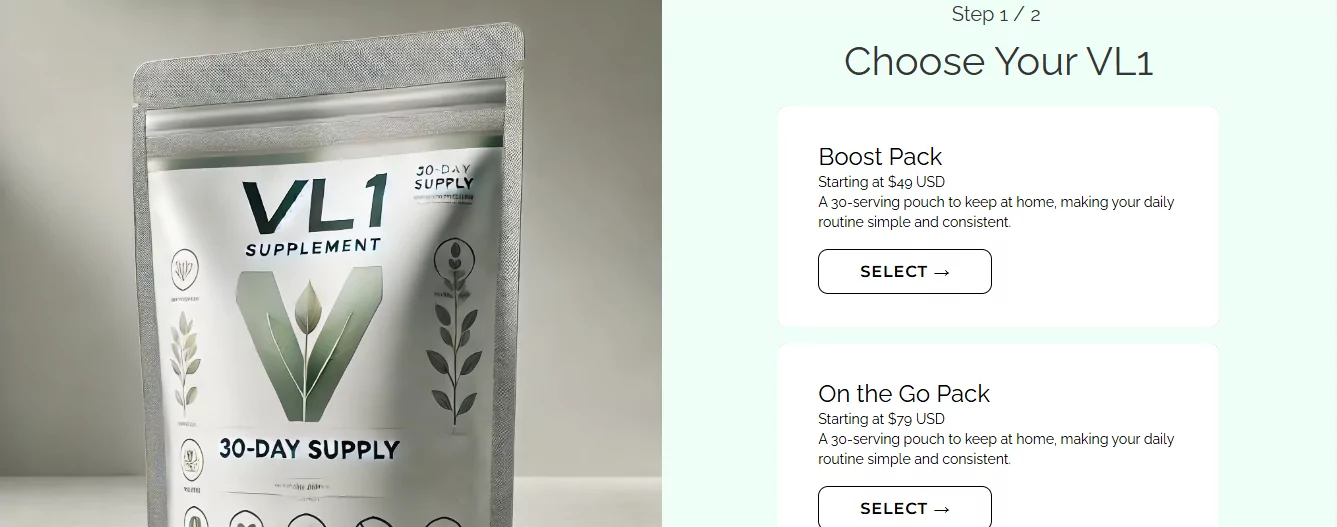
You can also read about Pure Roasters Coffee, a D2C coffee brand that switched to Subbly and saw its monthly recurring revenue increase 30x in just 3 months!
Take Your D2C Brand to the Next Level with Subbly
D2C marketing gives you complete control over selling and marketing your products, helping you build strong customer relationships and boost profits.
However, it also comes with challenges like increased responsibility and logistical complexities.
You can effectively reach and convert your target audience by using digital marketing strategies such as search marketing, influencer partnerships, and social media engagement.
If you want to streamline your D2C subscription business, Subbly provides everything you need to create a powerful, subscription-focused ecommerce website. Get started with Subbly today and take your D2C brand to the next level!

